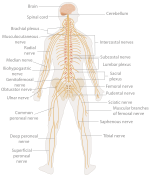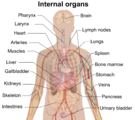Human anatomy
The skeleton
The nervous system
In some of its facets human anatomy is closely related to embryology, comparative anatomy and comparative embryology,[1] through common roots in evolution; for example, much of the human body maintains the ancient segmental pattern that is present in all vertebrates with basic units being repeated, which is particularly obvious in the vertebral column and in the ribcage, and can be traced from very early embryos.
The human body consists of biological systems, that consist of organs, that consist of tissues, that consist of cells and connective tissue.
The history of anatomy has been characterized, over a long period of time, by a continually developing understanding of the functions of organs and structures in the body. Methods have also advanced dramatically, advancing from examination of animals through dissection of fresh and preserved cadavers (dead human bodies) to technologically complex techniques developed in the 20th century.
Study
Generally, physicians, dentists, physiotherapists, nurses, paramedics, radiographers, and students of certain biological sciences, learn gross anatomy and microscopic anatomy from anatomical models, skeletons, textbooks, diagrams, photographs, lectures, and tutorials. The study of microscopic anatomy (or histology) can be aided by practical experience examining histological preparations (or slides) under a microscope; and in addition, medical and dental students generally also learn anatomy with practical experience of dissection and inspection of cadavers (dead human bodies). A thorough working knowledge of anatomy is required for all medical doctors, especially surgeons, and doctors working in some diagnostic specialities, such as histopathology and radiology.Human anatomy, physiology, and biochemistry are basic medical sciences, which are generally taught to medical students in their first year at medical school. Human anatomy can be taught regionally or systemically;[1] that is, respectively, studying anatomy by bodily regions such as the head and chest, or studying by specific systems, such as the nervous or respiratory systems. The major anatomy textbook, Gray's Anatomy, has recently been reorganized from a systems format to a regional format,[2][3] in line with modern teaching.
Anatomy in arts
Gross anatomy has become a key part of visual arts. Basic concepts of how muscles and bones function and deform with movement is key to drawing, painting or animating a human figure. Many books such as "Human Anatomy for Artists: The Elements of Form", are written as a guide to drawing the human body anatomically correctly.[4] Leonardo da Vinci sought to improve his art through a better understanding of human anatomy. In the process he advanced both human anatomy and its representation in art.Approaches
Regional groups
- Head and neck – includes everything above the thoracic inlet.
- Upper limb – includes the hand, wrist, forearm, elbow, arm, and shoulder.
- Thorax – the region of the chest from the thoracic inlet to the thoracic diaphragm.
- Human abdomen to the pelvic brim or to the pelvic inlet.
- The back – the spine and its components, the vertebrae, sacrum, coccyx, and intervertebral disks.
- Pelvis and Perineum – the pelvis consists of everything from the pelvic inlet to the pelvic diaphragm. The perineum is the region between the sex organs and the anus.
- Lower limb – everything below the inguinal ligament, including the hip, the thigh, the knee, the leg, the ankle, and the foot.
Internal organs (by region)
Head and neckThorax
Abdomen and pelvis (both sexes)
- Adrenal glands (2)
- Appendix
- Bladder
- Gallbladder (non-vital)
- Large intestine
- Small intestine
- Kidneys (2)
- Liver
- Pancreas - gland
- Spleen (non-vital)
- Stomach
Female pelvis
Major organ systems
Main article: Biological system
- Circulatory system: pumping and channeling blood to and from the body and lungs with heart, blood, and blood vessels.
- Digestive System: digestion and processing food with salivary glands, esophagus, stomach, liver, gallbladder, pancreas, intestines, rectum, and anus.
- Endocannabinoid system: neuromodulatory lipids and receptors involved in a variety of physiological processes including appetite, pain-sensation, mood, motor learning, synaptic plasticity, and memory.
- Endocrine system: communication within the body using hormones made by endocrine glands such as the hypothalamus, pituitary or pituitary gland, pineal body or pineal gland, thyroid, parathyroids, and adrenals or adrenal glands
- Integumentary system: skin, hair and nails
- Immune system: the system that fights off disease; composed of leukocytes, tonsils, adenoids, thymus, and spleen.
- Lymphatic system: structures involved in the transfer of lymph between tissues and the blood stream, the lymph and the nodes and vessels that transport it.
- Musculoskeletal system: muscles provide movement and a skeleton provides structural support and protection with bones, cartilage, ligaments, and tendons.
- Nervous system: collecting, transferring and processing information with brain, spinal cord and nerves
- Reproductive system: the sex organs; in the female; ovaries, fallopian tubes, uterus, vagina, mammary glands, and in the male; testicles, vas deferens, seminal vesicles, prostate, and penis.
- Respiratory system: the organs used for breathing, the pharynx, larynx, trachea, bronchi, lungs, and diaphragm.
- Urinary system: kidneys, ureters, bladder and urethra involved in fluid balance, electrolyte balance and excretion of urine.
- Vestibular system: contributes to our balance and our sense of spatial orientation.





0 comments:
Post a Comment